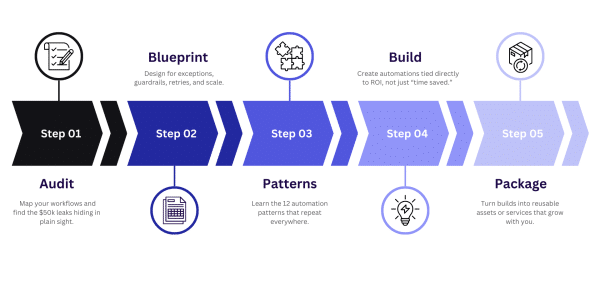What TikTok Gurus Aren’t Telling You About Automation
Automation looks simple on the surface.
Wire a few tools together, save a few hours, maybe even spin up an AI agent that feels impressive in a demo.
But here’s the uncomfortable truth: automations work fine in a demo, then start breaking as soon as the real world hits them with edge cases.
And when they fail, they don’t just waste time. They create hidden costs: a lead that never gets routed, a customer invoice that doesn’t send, an ops team babysitting workflows that were supposed to save them hours.
The problem isn’t Zapier, Make, or any other tool. The problem is the way people build. That’s why I’m starting this series — to show you the science of automation.
Why Most Automations Fail
Here’s the typical story: someone wires up a Zap or an AI agent. It works fine in testing. But two weeks later:
- A rep forgets to fill in the “region” field in the CRM → new leads never get assigned.
- A customer uploads a PDF instead of a CSV → the workflow crashes silently.
- An API integration hits a hidden rate limit → every fifth record gets skipped without warning.
On paper, these sound like small issues. In reality, they’re lost customers, missed revenue, and endless rework.
Most automations aren’t designed with error handling, guardrails, or exceptions. They look fine at first, but at scale, the cracks show everywhere.
Who cares?
This isn’t just a technical problem. It shows up differently depending on your role:
- Founders want automation but don’t know where to start. They burn cash on tasks that could be automated — or worse, automate the wrong things.
- Ops leaders are stuck firefighting fragile workflows. They spend mornings reconciling mismatched spreadsheets or restarting integrations that quietly failed overnight.
- Consultants know there’s huge demand for automation, but can’t prove ROI to clients. Deals stall because “saving time” isn’t enough.
Different roles. Same problem: automations that don’t last.
What’s Missing From Most Automations
Everyone’s chasing hacks. Zapier recipes. AI agent demos. YouTube tutorials that look slick but fall apart in the real world.
The truth? Tools change every month. Principles don’t.
Programming has decades of discipline: design patterns, error handling, observability, guardrails. Automation has none of that. Which means most people are guessing. They’re wiring things together blind.
That’s why automations collapse under pressure.
The Science of Automation
The fix isn’t another tool. It’s a shift in mindset.
To build automations that scale, you need a framework:
- Audit → Map your workflows and find the $50k leaks hiding in plain sight.
- Blueprint → Design for exceptions, guardrails, retries, and scale.
- Patterns → Learn the 12 automation patterns that repeat everywhere.
- Build → Create automations tied directly to ROI, not just “time saved.”
- Package → Turn builds into reusable assets or services that grow with you.
When you follow this path, automations stop being fragile hacks and start becoming invisible infrastructure — the kind you can trust to run in production.

Lessons from the field
I’ve spent my career building automation systems.
At Backendless, we’ve helped thousands of developers and businesses launch apps without rebuilding the same backend from scratch. That experience taught me one lesson:
The only way to scale software is to design for reliability from day one.
That lesson carried into automation. I’ve audited hundreds of workflows and built automations for dozens of businesses. And every time, the difference between success and failure came down to fundamentals.
That’s what this series is here to teach you.
What now?
So where do we go from here?
This isn’t about random hacks. It’s a playbook you can use to build automations and AI agents that actually scale.
Here’s what we’ll cover:
- Audits: How to uncover your highest-ROI workflows.
- Blueprinting: How to design for scale and resilience.
- The 12 Patterns: The periodic table of automation.
- Builds on Camera: Real-world proof of what works.
- Packaging: How to turn automations into recurring revenue.
By the end, you won’t just know how to use tools. You’ll know how to think like an automator.
Final Word
Most automations fail because people build blind. They copy tutorials, wire tools together, and hope it holds.
But hope isn’t a strategy.
With the right system, automation stops being fragile. It becomes the backbone of your business; invisible, reliable, and scalable.
That’s what this series is about.
Want to experience what reliable automation feels like? Start building on Flowrunner today— it’s designed with the principles we’ll cover in this series built right in.
Up next: How to audit your workflows and find the $50k leaks hiding in plain sight.
